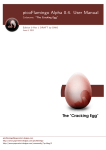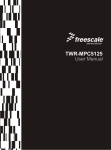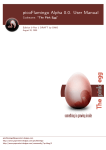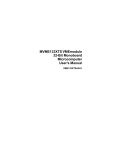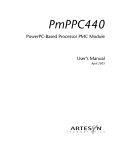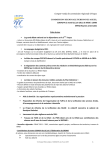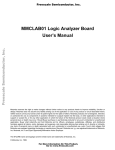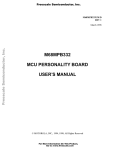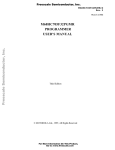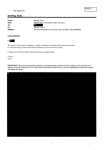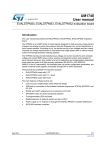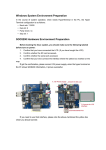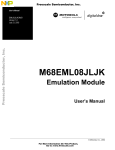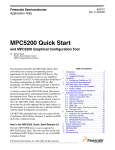Download Linux BSP for the Freescale Lite5200B EVB
Transcript
Linux BSP for the Freescale Lite5200B EVB User's Guide Rev. 2.0 07/2006 How to Reach Us: Home Page: www.freescale.com E-mail: [email protected] USA/Europe or Locations Not Listed: Freescale Semiconductor Technical Information Center, CH370 1300 N. Alma School Road Chandler, Arizona 85224 +1-800-521-6274 or +1-480-768-2130 [email protected] Europe, Middle East, and Africa: Freescale Halbleiter Deutschland GmbH Technical Information Center Schatzbogen 7 81829 Muenchen, Germany +44 1296 380 456 (English) +46 8 52200080 (English) +49 89 92103 559 (German) +33 1 69 35 48 48 (French) [email protected] Japan: Freescale Semiconductor Japan Ltd. Headquarters ARCO Tower 15F 1-8-1, Shimo-Meguro, Meguro-ku, Tokyo 153-0064, Japan 0120 191014 or +81 3 5437 9125 [email protected] Asia/Pacific: Freescale Semiconductor Hong Kong Ltd. Technical Information Center 2 Dai King Street Tai Po Industrial Estate Tai Po, N.T., Hong Kong +800 2666 8080 [email protected] For Literature Requests Only: Freescale Semiconductor Literature Distribution Center P.O. Box 5405 Denver, Colorado 80217 1-800-441-2447 or 303-675-2140 Fax: 303-675-2150 [email protected] Information in this document is provided solely to enable system and software implementers to use Freescale Semiconductor products. There are no express or implied copyright licenses granted hereunder to design or fabricate any integrated circuits or integrated circuits based on the information in this document. Freescale Semiconductor reserves the right to make changes without further notice to any products herein. Freescale Semiconductor makes no warranty, representation or guarantee regarding the suitability of its products for any particular purpose, nor does Freescale Semiconductor assume any liability arising out of the application or use of any product or circuit, and specifically disclaims any and all liability, including without limitation consequential or incidental damages. “Typical” parameters that may be provided in Freescale Semiconductor data sheets and/or specifications can and do vary in different applications and actual performance may vary over time. All operating parameters, including “Typicals”, must be validated for each customer application by customer’s technical experts. Freescale Semiconductor does not convey any license under its patent rights nor the rights of others. Freescale Semiconductor products are not designed, intended, or authorized for use as components in systems intended for surgical implant into the body, or other applications intended to support or sustain life, or for any other application in which the failure of the Freescale Semiconductor product could create a situation where personal injury or death may occur. Should Buyer purchase or use Freescale Semiconductor products for any such unintended or unauthorized application, Buyer shall indemnify and hold Freescale Semiconductor and its officers, employees, subsidiaries, affiliates, and distributors harmless against all claims, costs, damages, and expenses, and reasonable attorney fees arising out of, directly or indirectly, any claim of personal injury or death associated with such unintended or unauthorized use, even if such claim alleges that Freescale Semiconductor was negligent regarding the design or manufacture of the part. Learn More: For more information about Freescale products, please visit www.freescale.com. Freescale™ and the Freescale logo are trademarks of Freescale Semiconductor, Inc. All other product or service names are the property of their respective owners. © Freescale Semiconductor, Inc. 2006. All rights reserved. Contents About This Manual ............................................................................................. 1-1 Audience ................................................................................................................................................1-1 Organization...........................................................................................................................................1-1 Conventions ...........................................................................................................................................1-1 Definitions, Acronyms, and Abbreviations............................................................................................1-1 Chapter 1 Introduction ....................................................................................... 1-2 1.1 LTIB Overview ........................................................................................................................1-2 1.2 BSP Overview ..........................................................................................................................1-2 Chapter 2 LTIB Basics........................................................................................ 2-1 2.1 Installing the BSP .....................................................................................................................2-1 2.2 Running LTIB ..........................................................................................................................2-1 Chapter 3 Target Configuration.......................................................................... 3-1 3.1 Supported Target Revisions......................................................................................................3-1 3.2 Target Set-up ............................................................................................................................3-1 Chapter 4 Target Deployment ............................................................................. 4-1 4.1 Host Set-up ...............................................................................................................................4-1 4.2 Configuring u-boot ...................................................................................................................4-2 4.3 Development Depoyment .........................................................................................................4-3 4.4 Production Deployment............................................................................................................4-3 4.5 Flashing u-boot.........................................................................................................................4-3 Freescale Semiconductor Lite5200B BSP User Manual iii iv Lite5200B BSP User Manual Freescale Semiconductor About This Manual This User Manual provides information on the basic features supported by the BSP and provides you with instructions about how to accomplish these tasks: • Install the BSP on a host development system. • Run Linux Target Image Builder (LTIB) to build target images. • Deploy built images to the Lite5200B EVB. • Boot Linux on the Lite5200B EVB. Audience This document is addressed to developers who want to take advantage of the Freescale Linux Target Image Builder (LTIB) for the Lite5200B EVB Board Support Package (BSP). Organization This document is organized into 4 chapters. Chapter 1 Provides an introduction to the Lite5200B EVB BSP. Chapter 2 Provides basic information on LTIB Chapter 3 Provides important target set-up information Chapter 4 Provides host and target-specific build and deployment information Conventions This document uses the following notational conventions: • Courier monospaced type indicates commands, command parameters, code examples, expressions, data types, and directives. • Italic type indicates replaceable command parameters. • All source code examples are in C. Definitions, Acronyms, and Abbreviations The following list defines the abbreviations used in this document. BSP LTIB NFS Board Support Package Linux Target Image Builder Network File System TFTP Trivial File Transfer Protocol Freescale Semiconductor Lite5200B BSP User Manual 1-1 Chapter 1 Introduction 1.1 LTIB Overview The Linux Target Image Builder (LTIB) is a tools framework used to manage, configure, extend and build Linux software elements to easily build a Linux target image and a root filesystem. LTIB runs on an x86 PC running the Linux OS. This BSP operates with LTIB running on a host development system with the following: • • • • • • • Ethernet card Serial port 1 GB of free disk space required NFS Server TFTP Server rsync perl NOTE: Be aware that some host side packages may not function properly on every Linux distribution. The following are platforms where LTIB was tested. • • • • 1.2 Redhat: 7.3, 8.0, 9.0 Fedora Core: 1, 2, 3, 4 Debian: 3.1r0 (stable), unstable SuSE: 8.2, 9.2, 10.0 BSP Overview This Lite5200B EVB BSP is designed for use with LTIB. Once the BSP is installed and running with its basic configuration, you can use LTIB to customize your project. The BSP components provide the tools, device drivers, and additional features needed for your embedded Linux project. Pre-built Linux-2.6.16.11 kernel and packages with these features: • Ingo Molnar's realtime preemption patch • On-chip Serial port • FEC • Memory devices, including flash and DRAM • Controller Area Network • I2C Controller • USB Host (Tested with Mouse and Keyboard) • ATA/IDE Controller (PIO and UDMA) • PCI Bus (Tested with CoralPA card and Realtek 8139) U-boot 1.1.2 Toolchain (gcc 3.4.3, glib 2.3.6, binutils 2.16.1) 1-2 Lite5200B BSP User Manual Freescale Semiconductor GDB 6.3 Documentation. See START_HERE.htm on this CD. Freescale Semiconductor Lite5200B BSP User Manual 1-3 Chapter 2 LTIB Basics 2.1 Installing the BSP Please follow the steps below to install LTIB on your host machine. 1. As root, mount the ISO image on your machine: mount –o loop <target-bsp.iso> <mount point> 2. As a non-root user, install the LTIB: <mount point>/install The BSP EULA will be presented for acceptance. To continue install accept the licesnse. Then, input the desired LTIB install path. Be sure the user has the correct permissions for the install path.. There are no uninstall scripts. To uninstall LTIB you need to remove the /opt/freescale/pkgs, /opt/freescale/ltib and /ltib directories manually. 2.2 Running LTIB To run LTIB, change to the directory into which you installed it and run ./ltib. cd /<ltib install dir>/ ./ltib The first time LTIB runs on your machine a number of host packages are built and installed that support LTIB. This may take a few minutes. Important Note: Please be sure to set the “Target System Configuration” options for your network environment the first time you build. To modify the project configuration simply run: ./ltib –-configure (or -c; type --help to see configuration options) This will re-prompt you for the platform/board configuration. In the board configuration screens, change settings and select packages as appropriate. When you exit the configuration screen your target image will be adjusted accordingly. Freescale Semiconductor Lite5200B BSP User Manual 2-1 Once you build your project you will get following directory/image files: • • rootfs/ – directory, the root file system that will be deployed on your board. rootfs/boot/uImage – kernel image that can be loaded with U-boot If you want to fully re-configure and re-compile all the packages, you can do the following. This is generally not necessary. 1. Clean up all the configure files and objects thoroughly: ./ltib –m distclean 2. You will be prompted to confirm your choice. Type yes to perform a distclean. 3. Run litb ./ltib More information on LITB can be found in <install path>/<ltib install dir>/doc. Or on the web at http://savannah.nongnu.org/projects/ltib. 2-2 Lite5200B BSP User Manual Freescale Semiconductor Chapter 3 Target Configuration 3.1 Supported Target Revisions The target system is the Lite5200B EVB board. This BSP is known to work on the following board(s) revision(s): Lite5200B EVB: Rev K CoralP Card: Rev 5.0 3.2 Target Set-up 1. Disconnect the power supply from the target and set the board configuration switches. CFG 0 CFG 0 CFG 0 CFG 0 CFG 0 L H H H L XLB SYS FVCO MG LF L L L L L HI/LO WAIT SWAO WUDE MUXED H H L L L 2. Connect your board to the network via the Ethernet port. 3. Connect your board to your host machine via the serial port. For Linux, use the serial port marked “UART” next to the Ethernet jack. 4. Verify the dip switches are set correctly. Freescale Semiconductor Lite5200B BSP User Manual 3-1 Chapter 4 Target Deployment 4.1 Host Set-up Host setup is critical for your BSP to function. The host must be running tftp and nfs in order for deployment to work. The following instructions are generic. Your system may be different and the commands should be adjusted accordingly. 1. Turn off firewall for tftp to work. iptables -F or type "setup" at the command line. 2. Install tftp-server 3. Install nfs-server 4. Create the tftboot directory. mkdir /tftpboot 5. Link rootfs to an exportable directory once you have built your project. ln –s /<ltib install dir>/rootfs /tftpboot/ltib 6. Copy over kernel, bootloader, and flash filesystem images for your deployment to the /tftpboot directory cp /<ltib install dir>/rootfs/boot/uImage /tftpboot cp /<ltib install dir>/rootfs.jffs2 /tftpboot cp /<ltib install dir>/rootfs/boot/u-boot.bin /tftpboot 7. Edit /etc/exports and add the following line: /tftpboot/<ltib install dir>/ <target board IP>(rw,no_root_squash, async) 8. Edit /etc/xinetd.d/tftp to enable tftp like this: { disable socket_type protocol wait user server server_args } 9. = = = = = = = no dgram udp yes root /usr/sbin/in.tftpd /tftpboot Restart the nfs and tftp servers on your host /etc/init.d/xinetd restart /etc/init.d/nfsserver restart Freescale Semiconductor Lite5200B BSP User Manual 4-1 10. Connect board to the network 11. Connect the target to the host via a serial connection 12. Start minicom and set it up to talk to the target - Serial Setup: Select correct serial device; Hardware & Software Flow control = No; Bps = 115,200 - Modem & dialing: Delete text for the following: Init String, Reset String, Hang-up String, No flow control 13. Power on board and see the console prompt. 4.2 Configuring u-boot The factory installed u-boot has several commands predefined in the default environment. To verify that the u-boot you are using has these type 'print' at the u-boot prompt and you should see something like: bootcmd=run flash_self bootdelay=5 baudrate=115200 preboot=echo Type "run tftp_nfs" load kernel via tftp with nfs root;echo kernel_flash_addr=ffd00000 kernel_ram_addr=200000 kernel_flash_size=200000 jffs2args=setenv bootargs console=ttyPSC0,115200 root=/dev/mtdblock0 rw rootfstype=jffs2 nfsargs=setenv bootargs console=ttyPSC0,115200 root=/dev/nfs rw nfsroot=$(serverip):$(rootpath) netdev=eth0 addip=setenv bootargs $(bootargs) ip=$(ipaddr):$(serverip):$(gatewayip):$(netmask):$(hostname):$(netdev):off panic=1 tftp_nfs=tftp $(kernel_ram_addr) $(bootfile);run nfsargs addip;bootm cpkernel=cp $(kernel_flash_addr) $(kernel_ram_addr) $(kernel_flash_size) flash_nfs=run nfsargs addip cpkernel; bootm $(kernel_ram_addr)) flash_jffs2=run jffs2args cpkernel; bootm $(kernel_ram_addr) bootcmd=run tftp_nfs If the settings are wrong or missing type them in like this: setenv preboot 'echo Type "run tftp_nfs" to tfp kernel with nfs root;echo' setenv kernel_flash_addr ffd00000 setenv kernel_ram_addr 200000 setenv kernel_flash_size 200000 setenv jffs2args 'setenv bootargs console=ttyPSC0,115200 \ root=/dev/mtdblock0 rw rootfstype=jffs2' setenv nfsargs 'setenv bootargs console=ttyPSC0,115200 \ root=/dev/nfs rw nfsroot=$(serverip):$(rootpath)' setenv netdev eth0 setenv addip 'setenv bootargs $(bootargs) \ ip=$(ipaddr):$(serverip):$(gatewayip):$(netmask):$(hostname):\ $(netdev):off panic=1' setenv tftp_nfs 'tftp $(kernel_ram_addr) $(bootfile);run nfsargs addip;bootm' setenv cpkernel 'cp $(kernel_flash_addr) $(kernel_ram_addr) \ $(kernel_flash_size)' setenv flash_nfs 'run nfsargs addip cpkernel; bootm $(kernel_ram_addr))' 4-2 Lite5200B BSP User Manual Freescale Semiconductor setenv flash_jffs2 'run jffs2args cpkernel; bootm $(kernel_ram_addr)' setenv bootcmd 'run tftp_nfs' You must set the console to ttyPSC0,115200 for the Lite5200B EVB After verifying the above commands are in the u-boot environment proceed with the following steps to configure u-boot. 1. Set the board's network configuration setenv setenv setenv setenv 2. ipaddr 172.27.152.99 serverip 172.27.152.5 gatewayip 172.27.255.254 netmask 255.255.0.0 Set some pathnames needed later setenv rootpath /tftpboot/ltib setenv bootfile /tftpboot/uImage 3. Save the configuration to flash saveenv 4.3 Development Depoyment 1. Copy the kernel image to the tftpboot directory (On the host) cp /<ltib install dir>/rootfs/boot/uImage /tftpboot 2. Link rootfs to an exportable directory ln –s /<ltib install dir>/rootfs /tftpboot/ltib 3. Boot the kernel run tftp_nfs To automate this set the bootcmd variable: setenv bootcmd run tftp_nfs saveenv 4.4 Production Deployment 1. Copy the kernel image to the tftpboot directory (On the host) cp /<ltib install dir>/rootfs/boot/uImage /tftpboot 2. Download kernel and write it to flash tftp 1000000 /tftpboot/uImage erase ffd00000 ffefffff cp.b 1000000 ffd00000 $(filesize) 3. Split the jffs2 flash image into two files if it is larger than 16M. Freescale Semiconductor Lite5200B BSP User Manual 4-3 (On the host) split -a 1 -d -b 16m rootfs.jffs2 rootfs.jffs2_ This will create a file called rootfs.jffs2_0. A second file called rootfs.jffs2_1 will also be created if the rootfs image is greater than 16M in size. 4. Copy the split jffs2 flash image files to the tftpboot directory (On the host) cp /<ltib install dir>/rootfs.jffs2_* /tftpboot 5. Erase the filesystem flash erase fe000000 feffffff erase ff000000 ffcfffff 6. Download and flash the first 16M of the jffs2 flash image (this can take almost 10 minutes) tftp 1000000 /tftpboot/rootfs.jffs2_0 cp.b 1000000 fe000000 $(filesize) 7. Download and flash the remainder of the jffs2 flash image (only if the image is larger than 16M) tftp 1000000 /tftpboot/rootfs.jffs2_1 cp.b 1000000 ff000000 $(filesize) 8. Boot kernel in flash with jffs2 filesystem. The first time you boot jffs2 it will take some time. run flash_jffs2 To have this automatically happen at boot set bootcmd set bootcmd run flash_jffs2 saveenv 4.5 Flashing u-boot To restore the factory u-boot move jumper J10 (BOOT SEL) to the B/U position and reset the board. When the board boots the factory default u-boot image will be copied to the main flash. When complete you will be instructed to move the jumper back to the MAIN position. To replace u-boot with one compiled with ltib follow these steps: 1. Setup u-boot networking parameters (See Section 4.3) 2. Copy the u-boot binary image to the tftpboot directory (On the host) cp /<ltib install dir>/rootfs/boot/u-boot.bin /tftpboot 3. Download u-boot via tftp tftp 1000000 /tftpboot/u-boot.bin 4. Save u-boot to flash protect off fff00000 fff5ffff erase fff00000 fff5ffff cp.b 1000000 fff00000 $(filesize) 4-4 Lite5200B BSP User Manual Freescale Semiconductor Freescale Semiconductor Lite5200B BSP User Manual 4-5




















